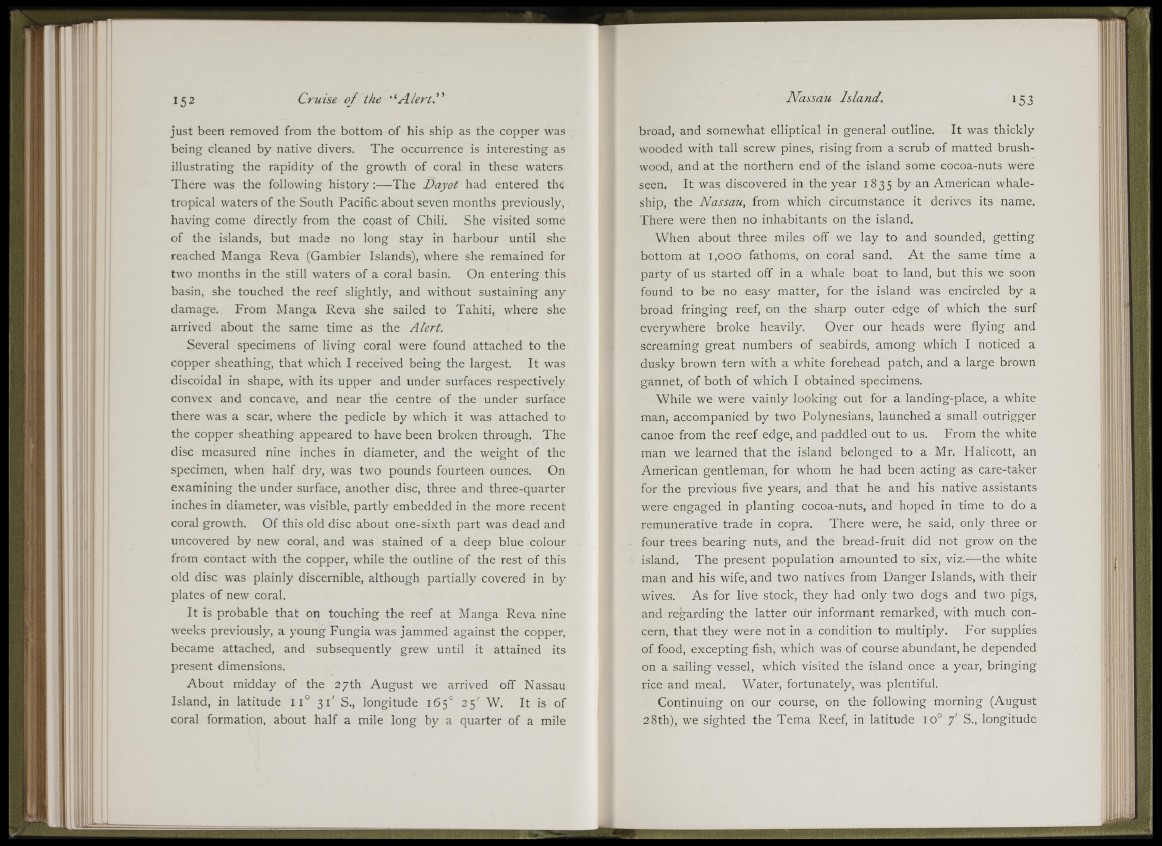
m 1
1
|kv t
■n 'Ti
just been removed from the bottom of his ship as the copper was
being cleaned by native divers. The occurrence is interesting as
illustrating the rapidity of the growth of coral in these waters
There was the following history :— The Dayot had entered the
tropical waters of the South Pacific about seven months previously,
having come directly from the coast of Chili. She visited some
of the islands, but made no long stay in harbour until she
reached Manga Reva (Gambier Islands), where she remained for
two months in the still waters of a coral basin. On entering this
basin, she touched the reef slightly, and without sustaining any
damage.. From Manga Reva she sailed to Tahiti, where she
arrived about the same time as the Alert.
Several specimens of living coral were found attached to the
copper sheathing, that which I received being the largest. It was
discoidal in shape, with its upper and under surfaces respectively
convex and concave, and near the centre of the under surface
there was a scar, where the pedicle by which it was attached to
the copper sheathing appeared to have been broken through. The
disc measured nine inches in diameter, and the weight of the
specimen, when half dry, was two pounds fourteen ounces. On
examining the under surface, another disc, three and three-quarter
inches in diameter, was visible, partly embedded in the more recent
coral growth. Of this old disc about one-sixth part was dead and
uncovered by new coral, and was stained of a deep blue colour
from contact with the copper, while the outline of the rest of this
old disc was plainly discernible, although partially covered in by
plates of new coral.
It is probable that on touching the reef at Manga Reva nine
weeks previously, a young Fungia was jammed against the copper,
became attached, and subsequently grew until it attained its
present dimensions.
About midday of the 27th August we arrived off Nassau
Island, in latitude 11° 31' S., longitude 165° 25' W. It is of
coral formation, about half a mile long by a quarter of a mile
broad, and somewhat elliptical in general outline. It was thickly
wooded with tall screw pines, rising from a scrub of matted brushwood,
and at the northern end of the island some cocoa-nuts were
seen. It was discovered in the year 1835 by an American whale-
ship, the Nassau, from which circumstance it derives its name.
There were then no inhabitants on the island.
When about three miles off we lay to and sounded, getting
bottom at 1,000 fathoms, on coral sand. A t the same time a
party of us started off in a whale boat to land, but this we soon
found to be no easy matter, for the island was encircled by a
broad fringing reef, on the sharp outer edge of which the surf
everywhere broke heavily. Over our heads were fiying and
screaming great numbers of seabirds, among which I noticed a
dusky brown tern with a white forehead patch, and a large brown
gannet, of both of which I obtained specimens.
While we were vainly looking out for a landing-place, a white
man, accompanied by two Polynesians, launched a small outrigger
canoe from the reef edge, and paddled out to us. From the white
man we learned that the island belonged to a Mr. Halicott, an
American gentleman, for whom he had been acting as care-taker
for the previous five years, and that he and his native assistants
were engaged in planting cocoa-nuts, and hoped in time to do a
remunerative trade in copra. There were, he said, only three or
four trees bearing nuts, and the bread-fruit did not grow on the
island. The present population amounted to six, viz.— the white
man and his wife, and two natives from Danger Islands, with their
wives. As for live stock, they had only two dogs and two pigs,
and regarding the latter our informant remarked, with much concern,
that they were not in a condition to multiply. For supplies
of food, excepting fish, which was of course abundant, he depended
on a sailing vessel, which visited the island once a year, bringing
rice and meal. Water, fortunately, was plentiful.
Continuing on our course, on the following morning (August
28th), we sighted the Tema Reef, in latitude 10° 7' S., longitude
m»:..
Afl
w